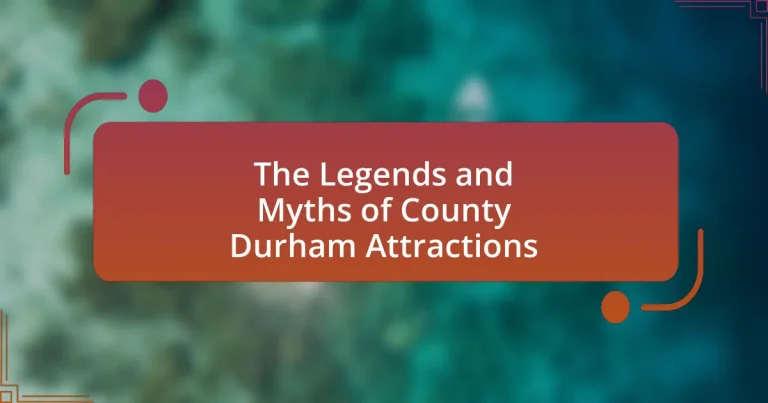The article focuses on the legends and myths associated with attractions in County Durham, highlighting notable tales such as the Lambton Worm and the haunting of the Bowes Museum. It explores how these narratives shape the region’s cultural identity, foster community pride, and enhance the visitor experience. Additionally, the article examines the economic impact of these myths on local tourism and discusses specific attractions tied to these stories, including Durham Cathedral and Brancepeth Castle. It also outlines how local communities engage with these legends through storytelling events and festivals, emphasizing their significance in preserving County Durham’s cultural heritage.

What are the Legends and Myths of County Durham Attractions?
County Durham attractions are steeped in legends and myths, with notable examples including the tale of the Lambton Worm, a dragon-like creature defeated by John Lambton, and the haunting of the Bowes Museum, which is said to be visited by the ghost of its founder, John Bowes. The Lambton Worm legend, originating from the 13th century, emphasizes themes of bravery and redemption, while the Bowes Museum ghost story adds an element of intrigue and mystery to the cultural heritage of the area. These narratives not only enrich the historical context of County Durham but also enhance the visitor experience by connecting them to the region’s folklore.
How do these legends and myths shape the identity of County Durham?
Legends and myths significantly shape the identity of County Durham by fostering a sense of cultural heritage and community pride. These narratives, such as the tale of the Lambton Worm and the story of St. Cuthbert, are deeply embedded in the local history and folklore, influencing the region’s traditions and celebrations. For instance, the Lambton Worm legend not only serves as a tourist attraction but also symbolizes the resilience and bravery of the local people, reinforcing their collective identity. Additionally, St. Cuthbert’s legacy, celebrated through various festivals and historical sites, highlights the spiritual and historical significance of the area, further solidifying County Durham’s unique identity within the broader context of English heritage.
What are some of the most famous legends associated with County Durham attractions?
Some of the most famous legends associated with County Durham attractions include the tale of the Lambton Worm, which tells of a monstrous serpent that terrorized the area until it was defeated by John Lambton. Another notable legend is the story of the Black Shuck, a ghostly black dog said to haunt the region, particularly around the ruins of Finchale Priory. Additionally, the legend of St. Cuthbert, who is believed to have performed miracles and whose shrine at Durham Cathedral attracts pilgrims, is significant in the area’s folklore. These legends are rooted in local history and culture, contributing to the rich narrative surrounding County Durham’s attractions.
How do local communities engage with these myths?
Local communities engage with the myths of County Durham attractions through storytelling, festivals, and educational programs. These activities foster a sense of identity and heritage, as residents share tales of local legends like the Lambton Worm and the story of the Dun Cow. Events such as the annual Durham Miners’ Gala often incorporate these myths, allowing community members to celebrate their cultural history collectively. Additionally, schools and local organizations promote awareness of these myths through workshops and presentations, ensuring that the stories are passed down to future generations. This engagement not only preserves the myths but also strengthens community bonds and enhances local tourism.
Why are these legends important to County Durham’s cultural heritage?
Legends are important to County Durham’s cultural heritage because they embody the region’s history, values, and identity. These narratives, such as the tale of the Lambton Worm and the story of St. Cuthbert, serve as a means of preserving local traditions and fostering community pride. They provide insight into the beliefs and customs of past generations, reflecting the social and moral lessons that shaped the community. Furthermore, these legends attract tourism, contributing to the local economy and ensuring that the stories are passed down through generations, thus maintaining their relevance in contemporary culture.
What role do these myths play in tourism and local economy?
Myths play a significant role in tourism and the local economy by attracting visitors to County Durham attractions. These legends create a unique cultural identity that enhances the appeal of the region, leading to increased foot traffic and spending in local businesses. For instance, the story of the Lambton Worm draws tourists to the area, contributing to the economic vitality through hospitality, retail, and entertainment sectors. According to a report by Visit County Durham, heritage tourism, which includes myth-related attractions, generates millions in revenue annually, underscoring the economic impact of these narratives.
How do these stories reflect the history of the region?
The stories of County Durham reflect the region’s history by encapsulating its cultural heritage, historical events, and local traditions. For instance, legends such as the tale of the Lambton Worm illustrate the historical significance of the area’s folklore, which often intertwines with real historical figures and events, showcasing the community’s values and fears. Additionally, these narratives often serve as a means of preserving local history, as seen in the story of St. Cuthbert, which highlights the region’s early Christian heritage and its impact on the development of Durham as a religious center. Such stories not only entertain but also educate residents and visitors about the historical context and identity of County Durham.

What specific attractions in County Durham are tied to legends and myths?
Specific attractions in County Durham tied to legends and myths include the legendary Brancepeth Castle, known for its ghost stories and tales of the White Lady, and the historic Durham Cathedral, which is associated with the legend of St. Cuthbert and the miraculous events surrounding his relics. Brancepeth Castle dates back to the 11th century and has a rich history of hauntings, while Durham Cathedral, a UNESCO World Heritage Site, is linked to the life of St. Cuthbert, whose influence is deeply embedded in local folklore.
Which historical sites are known for their legendary tales?
Historical sites known for their legendary tales in County Durham include Durham Cathedral, known for its association with the legend of St. Cuthbert, and Barnard Castle, which is linked to the tale of the ghostly White Lady. Durham Cathedral, a UNESCO World Heritage Site, is said to house the relics of St. Cuthbert, whose miracles and stories have been passed down through generations. Barnard Castle, a medieval fortress, is famous for the legend of the White Lady, believed to be the spirit of a former resident who appears to warn of impending danger. These sites are steeped in history and folklore, making them significant attractions for those interested in legendary tales.
What unique stories are associated with Durham Cathedral?
Durham Cathedral is associated with several unique stories, including the legend of St. Cuthbert’s body, which was said to have performed miracles after his death. The cathedral houses the shrine of St. Cuthbert, a significant figure in Christianity, whose remains were believed to have healing powers, attracting pilgrims for centuries. Additionally, the story of the “Venerable Bede,” a monk who chronicled the history of the church and is buried in the cathedral, adds to its historical significance. The cathedral’s construction itself is steeped in legend, with tales of its builders facing supernatural challenges, including the story of the “Devil’s Bridge,” which suggests that the devil was tricked into helping build the structure. These narratives contribute to the rich tapestry of myths surrounding Durham Cathedral, making it a focal point of local folklore and history.
How does the legend of the Lambton Worm relate to local attractions?
The legend of the Lambton Worm is directly tied to local attractions in County Durham, particularly through the historic site of Lambton Castle and the nearby River Wear. This legend, which tells the story of a monstrous worm defeated by John Lambton, has become a cultural symbol for the area, attracting visitors interested in folklore and history. The tale is commemorated in local events and signage, enhancing the visitor experience by providing a narrative context to the attractions. Additionally, the annual Lambton Worm Festival celebrates this legend, drawing tourists and locals alike, thereby reinforcing the connection between the myth and the region’s cultural heritage.
What natural landmarks in County Durham have their own myths?
Natural landmarks in County Durham that have their own myths include the Angel of the North, which is said to be a guardian figure, and the mysterious landscape of High Force, associated with tales of fairies and spirits. The Angel of the North, a large steel sculpture, is often linked to local folklore about protection and hope, while High Force, one of England’s largest waterfalls, is steeped in legends of supernatural beings and ancient rituals. These landmarks are not only significant for their physical presence but also for the rich tapestry of stories that surround them, reflecting the cultural heritage of the region.
What is the significance of High Force Waterfall in local folklore?
High Force Waterfall holds significant importance in local folklore as it is often associated with tales of supernatural beings and mythical events. The waterfall is believed to be a site where fairies and spirits are said to dwell, influencing the natural landscape and the lives of nearby inhabitants. Local legends recount stories of enchanted creatures that protect the area, making it a focal point for cultural narratives and community identity in County Durham. These folklore elements contribute to the waterfall’s status as a revered natural landmark, attracting visitors who seek to connect with its mystical heritage.
How do the landscapes contribute to the legends of the area?
The landscapes of County Durham significantly contribute to the legends of the area by providing a dramatic and evocative backdrop that inspires storytelling. The rugged hills, ancient woodlands, and mysterious rivers create an atmosphere that fosters myths, such as those surrounding the legendary figure of the dragon in the story of St. Cuthbert, where the landscape’s features are often described as having mystical qualities. Additionally, the presence of historical sites like the ruins of castles and abbeys within these landscapes adds a layer of authenticity to the legends, as they are often tied to real events or figures from history, enhancing the narrative’s credibility. The unique geological formations, such as the Whin Sill, are also woven into local folklore, illustrating how the physical environment shapes cultural narratives and collective memory.

How can visitors experience the legends and myths of County Durham?
Visitors can experience the legends and myths of County Durham through various attractions and events that highlight the region’s rich folklore. Key sites include the historic Durham Cathedral, which is associated with the legend of St. Cuthbert, and the nearby Lindisfarne Priory, linked to tales of early Christian saints. Additionally, guided tours often focus on local myths, such as the story of the Lambton Worm, providing immersive storytelling experiences. Events like the annual Durham Book Festival also feature themes related to local legends, allowing visitors to engage with the cultural narratives of the area.
What tours or events highlight these legends for tourists?
Tours and events that highlight the legends of County Durham for tourists include the “Durham Ghost Walk,” which explores local ghost stories and folklore, and the “Bishop Auckland Castle Tours,” where visitors learn about the legends surrounding the castle’s history. Additionally, the “Beamish Museum” offers immersive experiences that showcase the myths and legends of the region through historical reenactments. These events are designed to engage tourists with the rich narrative heritage of County Durham, providing context and storytelling that enhances the understanding of local legends.
How can visitors participate in local storytelling events?
Visitors can participate in local storytelling events by attending scheduled sessions at community centers, libraries, or cultural festivals in County Durham. These events often welcome audience members to share their own stories or experiences related to local legends and myths, fostering an interactive environment. Additionally, many storytelling events provide opportunities for visitors to sign up in advance to tell their stories, ensuring a diverse range of narratives that reflect the rich cultural heritage of the area. Participation can also include engaging with local storytellers through workshops that enhance storytelling skills, thereby deepening the connection to County Durham’s folklore.
What resources are available for those interested in exploring these myths?
Books, academic journals, and online databases are valuable resources for those interested in exploring the myths of County Durham attractions. Specific titles such as “The Folklore of County Durham” provide detailed accounts of local legends, while journals like “Folklore” publish peer-reviewed articles on regional myths. Additionally, websites like the County Durham Heritage website offer curated information and resources related to local folklore and attractions. These resources collectively enhance understanding and appreciation of the myths associated with County Durham.
What tips can enhance the experience of exploring County Durham’s legends?
To enhance the experience of exploring County Durham’s legends, visitors should engage with local storytelling events and guided tours that focus on the region’s rich folklore. Participating in these activities allows individuals to gain deeper insights into the historical context and cultural significance of the legends. For instance, the Durham Ghost Walk offers narratives that connect participants with the area’s haunted history, while local festivals often celebrate traditional tales, providing immersive experiences. Additionally, researching specific legends, such as the story of the Lambton Worm, can enrich understanding and appreciation of the sites associated with these myths.
How can visitors engage with locals to learn more about the myths?
Visitors can engage with locals to learn more about the myths by participating in community events, such as storytelling nights or local festivals that celebrate regional folklore. These events often feature local storytellers who share traditional tales and legends, providing firsthand insights into the cultural significance of the myths. Additionally, visitors can join guided tours led by local historians or cultural experts who specialize in the myths of County Durham, offering a deeper understanding of the narratives and their historical context. Engaging in conversations with local residents in cafes or shops can also yield personal anecdotes and interpretations of the myths, enriching the visitor’s experience.
What are the best times of year to experience these attractions and their stories?
The best times of year to experience the attractions and their stories in County Durham are during spring and autumn. Spring, particularly from late March to May, offers mild weather and blooming landscapes, enhancing the experience of historical sites like Durham Cathedral and the surrounding areas rich in legend. Autumn, from September to November, provides vibrant foliage and often hosts local festivals that celebrate the region’s myths and folklore, making it an ideal time for immersive storytelling experiences. These seasons not only provide favorable weather conditions but also align with cultural events that highlight the legends and myths associated with County Durham attractions.




